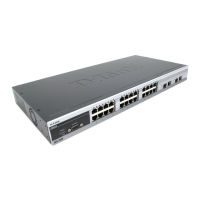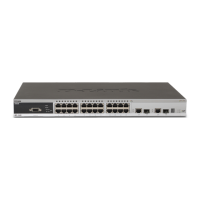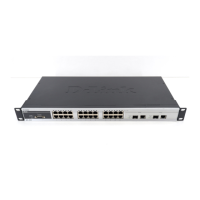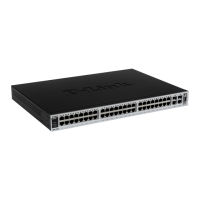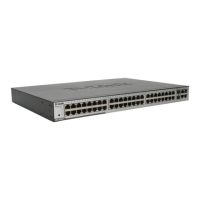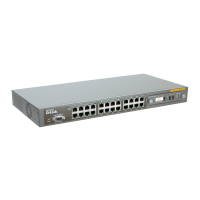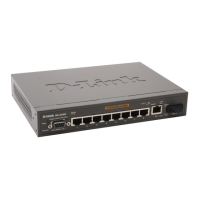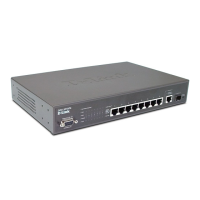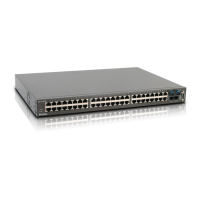Do you have a question about the D-Link DES-3528 and is the answer not in the manual?
Explains the Gigabit Ethernet technology and its benefits for network performance and upgrades.
Provides a detailed overview of the DES-3528 switch, its physical characteristics, and capabilities.
Lists the key technical features, standards, and protocols supported by the DES-3528 switch.
Explains the function and status indication of each LED on the switch for power, console, and port activity.
Provides guidelines for selecting an optimal installation site and environment for the switch.
Guides users on mounting the switch into a standard 19-inch rack using provided brackets.
Explains how to connect the power cord and turn on the switch, noting initial LED behavior.
Details how to connect end devices like PCs to the switch ports using twisted-pair cables.
Guides on utilizing SFP combo ports for high-speed connections to network backbones or servers.
Provides instructions for connecting to the switch's console port for initial setup and command-line management.
Describes how to assign an IP address to the switch, enabling network management and remote access.
Guides users on how to access the switch's web interface by entering its IP address in a browser.
Explains the layout and functions of the web manager's graphical interface, including key areas.
Describes how to view and configure basic system details like name, location, and contact information for the switch.
Details the process of configuring the switch's IP address, subnet mask, default gateway, and management VLAN.
Describes how to configure individual port parameters like state, speed, duplex mode, flow control, and address learning.
Details how to globally enable or disable SNMP settings on the switch, controlling its network management capabilities.
Explains how to enable or disable the Jumbo Frame feature for transmitting larger Ethernet frames, improving efficiency.
Covers VLAN concepts, including IEEE 802.1p priority and VLAN description.
Explains the QinQ function for carrying traffic from multiple users across a network by inserting SPVLAN tags.
Explains the function and configuration of STP loopback detection to prevent network loops caused by BPDU packet issues.
Details how to configure global Spanning Tree parameters like STP status, version, bridge max age, and hello time.
Explains the traffic control feature for managing packet storms and limiting traffic flow based on threshold levels.
Describes how to configure SRED parameters, including drop modes and thresholds, for probabilistic packet dropping.
Explains the Safeguard Engine's function in protecting the switch from packet flooding attacks by managing CPU load.
Explains the IP-MAC-Port Binding feature for restricting network access to authorized users by binding IP and MAC addresses to specific ports.
Introduces the 802.1x standard for network access control, covering port-based and MAC-based authentication using RADIUS.
Guides users on creating access profiles and ACL rules using a wizard, automating the process of defining access criteria.
Describes how to view and manage configured access profiles, including adding, deleting, and viewing details of ACL profiles.
Explains how to view the CPU utilization percentage of the switch, displayed as a real-time graphic.
Explains how to view port error statistics, including CRC errors, undersize, oversize, dropped packets, and jabber counts.
Describes how to view current ARP entries on the switch, search for specific entries, and clear the ARP table.
Explains the process of backing up and restoring configuration files using dual image storage for reliable configuration management.
Details the options for resetting the switch to factory defaults, including retaining user accounts and history logs.
Covers power supply specifications, power consumption, operating temperature, humidity, dimensions, weight, and EMI/Safety compliance.
Lists key performance features like wire speed operation, switching capacity, packet forwarding rates, and priority queues.
Explains how Packet Content ACL can mitigate ARP spoofing attacks by inspecting packet headers and blocking invalid ARP packets.
Explains the Gigabit Ethernet technology and its benefits for network performance and upgrades.
Provides a detailed overview of the DES-3528 switch, its physical characteristics, and capabilities.
Lists the key technical features, standards, and protocols supported by the DES-3528 switch.
Explains the function and status indication of each LED on the switch for power, console, and port activity.
Provides guidelines for selecting an optimal installation site and environment for the switch.
Guides users on mounting the switch into a standard 19-inch rack using provided brackets.
Explains how to connect the power cord and turn on the switch, noting initial LED behavior.
Details how to connect end devices like PCs to the switch ports using twisted-pair cables.
Guides on utilizing SFP combo ports for high-speed connections to network backbones or servers.
Provides instructions for connecting to the switch's console port for initial setup and command-line management.
Describes how to assign an IP address to the switch, enabling network management and remote access.
Guides users on how to access the switch's web interface by entering its IP address in a browser.
Explains the layout and functions of the web manager's graphical interface, including key areas.
Describes how to view and configure basic system details like name, location, and contact information for the switch.
Details the process of configuring the switch's IP address, subnet mask, default gateway, and management VLAN.
Describes how to configure individual port parameters like state, speed, duplex mode, flow control, and address learning.
Details how to globally enable or disable SNMP settings on the switch, controlling its network management capabilities.
Explains how to enable or disable the Jumbo Frame feature for transmitting larger Ethernet frames, improving efficiency.
Covers VLAN concepts, including IEEE 802.1p priority and VLAN description.
Explains the QinQ function for carrying traffic from multiple users across a network by inserting SPVLAN tags.
Explains the function and configuration of STP loopback detection to prevent network loops caused by BPDU packet issues.
Details how to configure global Spanning Tree parameters like STP status, version, bridge max age, and hello time.
Explains the traffic control feature for managing packet storms and limiting traffic flow based on threshold levels.
Describes how to configure SRED parameters, including drop modes and thresholds, for probabilistic packet dropping.
Explains the Safeguard Engine's function in protecting the switch from packet flooding attacks by managing CPU load.
Explains the IP-MAC-Port Binding feature for restricting network access to authorized users by binding IP and MAC addresses to specific ports.
Introduces the 802.1x standard for network access control, covering port-based and MAC-based authentication using RADIUS.
Guides users on creating access profiles and ACL rules using a wizard, automating the process of defining access criteria.
Describes how to view and manage configured access profiles, including adding, deleting, and viewing details of ACL profiles.
Explains how to view the CPU utilization percentage of the switch, displayed as a real-time graphic.
Explains how to view port error statistics, including CRC errors, undersize, oversize, dropped packets, and jabber counts.
Describes how to view current ARP entries on the switch, search for specific entries, and clear the ARP table.
Explains the process of backing up and restoring configuration files using dual image storage for reliable configuration management.
Details the options for resetting the switch to factory defaults, including retaining user accounts and history logs.
Covers power supply specifications, power consumption, operating temperature, humidity, dimensions, weight, and EMI/Safety compliance.
Lists key performance features like wire speed operation, switching capacity, packet forwarding rates, and priority queues.
Explains how Packet Content ACL can mitigate ARP spoofing attacks by inspecting packet headers and blocking invalid ARP packets.
| Layer | Layer 2 |
|---|---|
| Switching Capacity | 12.8 Gbps |
| Forwarding Rate | 9.5 Mpps |
| MAC Address Table | 8K |
| Operating Humidity | 10% to 90% non-condensing |
| Management | Web-based, SNMP |
| Jumbo Frame Support | Yes |
| Dimensions (W x D x H) | 440 x 250 x 44 mm |
| Operating Temperature | 0 to 50 °C |
| Storage Temperature | -40°C to 70°C |
| Standards Compliance | IEEE 802.3, IEEE 802.3u, IEEE 802.3x, IEEE 802.1Q |
| Device Type | Managed Layer 2 Switch |
| Ports | 24 x 10/100BASE-TX + 4 x Combo Gigabit (SFP/RJ45) |
